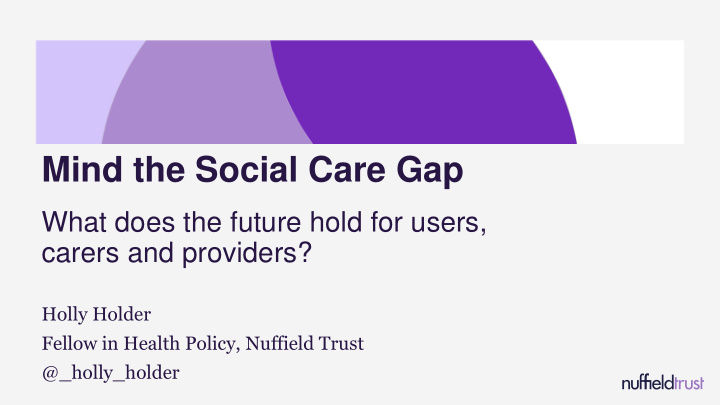



Mind the Social Care Gap What does the future hold for users, carers and providers? Holly Holder Fellow in Health Policy, Nuffield Trust @_holly_holder
Who pays for care? Person with social care needs National/ Families / local carers Government
The current situation • Public support only for those with very high needs AND low income • Majority either have to pay for Person with social care needs care themselves • Or rely increasingly on their families or unpaid carers National/ • Or people choose to go without = local Families / carers Government rise in unmet need Are we protecting everyone who needs support?
Risk to access and quality of services • Inequality by where you live and how much money you have Lower fees to providers = difficult to maintain standards • • Reliance on self-funders to cross-subsidise Innovation in wealthier areas • • No career path for care workers; Brexit • The result = providers are leaving the market How much choice and control to service users have? How long are people waiting for their care packages?
Local authority spend on social care 5
“We’ve pulled out anything that is, what we would almost say now is the nice stuff, the wrap- around stuff… we haven’t got many places to go” Local authority Director of Adult Social Services Quotes taken from Humphries et al (2016) Social care for older people. Home Truths. Nuffield Trust/The King’s Fund: London
Impact on social care providers • Fee levels making it difficult to maintain quality standards • Lack of career path for care workers and competition with retail • Intensification of the needs of social care users • VCS providers seeking to diversify their income streams • Difficulties contracting with the NHS • Increasing fees for users • Providers are leaving the market 7
“I think ultimately quality has to suffer” Social care provider
Impact on the NHS 9
Impact on service users and carers • Local authorities: emphasis that savings had been designed to avoid harming service users or carers • But unmet need is rising • More complaints to Ombudsman and poorer inspections Voluntary sector provider: without a solution to the • funding pressures “people will be dying in the homes… alone. Or suffer.” Increasing pressure on carers • 10
What next? Funding • Implications of a Dilnot-style cap of life time expenditure and raising the means-test • Social care funding gap for 2017-18 is £2.4 billion (The King’s Fund estimates) Spring budget and precept: are they enough? • • Better Care Fund used to fill gaps rather than innovate • NHS required to make £22bn efficiency savings by 2020 11
What next? Green paper Do we want to a) support people to save for their future, and/or b) see social care as a ‘social risk’ and put more money into the general pot? • Investing in future: work being done by the ABI and others • International funding models: Social insurance models: Germany, Japan • • Increased taxation: Sweden • Care Act (2014) and Dilnot cap and means test 12
What next? Public debate Are we / do we want to redefine the boundaries between • publicly funded support and what is expected of individuals? Achieving an ‘asset - based approach’ requires: • • Dialogue with the public • A vibrant voluntary and community sector Availability and willingness of families • • Health and care services able to support people to live at home 13
What next? Integration • Innovation in new service models between NHS and social care: • Salford – transfer of LA staff to local hospital • Devon hospital – taken over management of care home services • Whittington hospital – better coordination with care homes • Manchester – devolution But NAO report warns that integration of health and social • care has so far not delivered all of the expected benefits and the Better Care Fund has not achieved expected value for money. 14
www.nuffieldtrust.org.uk Follow us on Twitter – twitter.com/NuffieldTrust Sign up for our newsletter – www.nuffieldtrust.org.uk/newsletter-signup
Recommend
More recommend